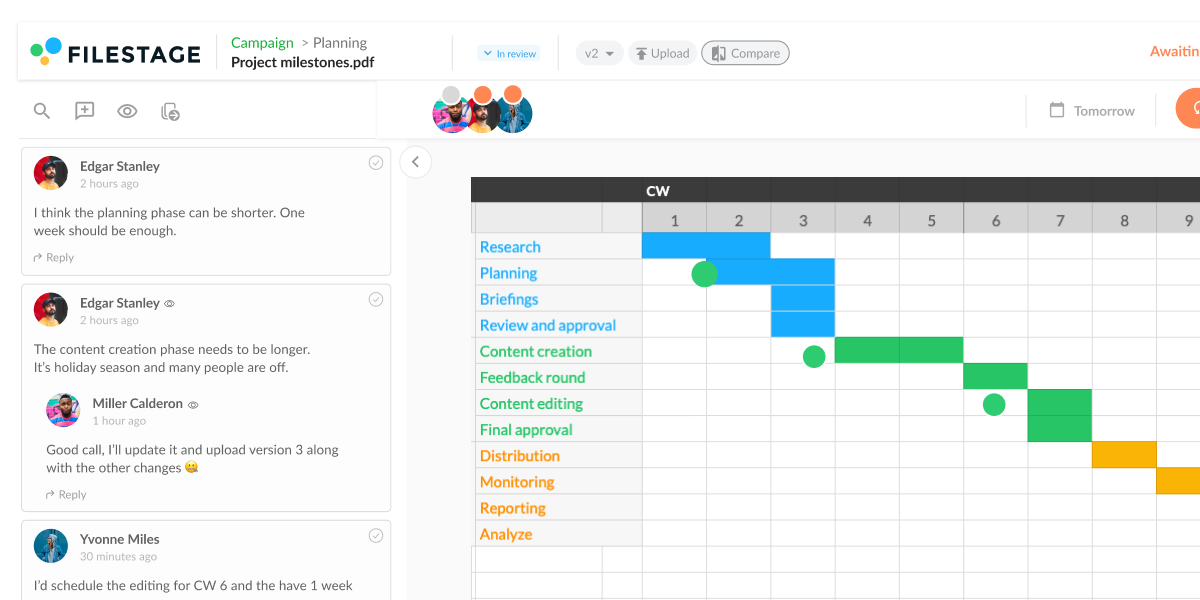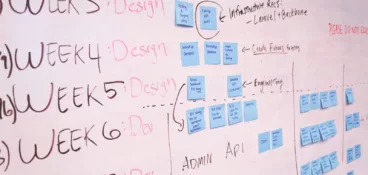Defining project milestones is important in helping you complete your project on time and keeping track of the project progress. With project milestones, you can represent the defined goals of a project to the stakeholders, as well as communicating the timeline to achieve them. To simply state it, milestones are checkpoints in a project’s journey.
Sometimes, understanding how to go about writing and collating milestones can be a chore. In this article, you’ll get to understand what a project milestone is, the importance of these milestones and how to define and manage them.
What is a project milestone?
Project milestones help you break down a project into smaller sections, so you have a clear idea of what tasks need to be completed and by when. Unlike deadlines and goals, which can refer to smaller, more specific tasks, milestones outline the project roadmap and are part of the project’s bigger picture.
Project milestones are used as a method for defining important phases in a project. They can either mark the major progress points or can be broken down into smaller goal points. Either way, project milestones are important for measuring progress – in small bits or in chunks.
The smarter way to request approval
Get collaborative feedback on everything from creative assets to contracts – all in one place.
The importance of project milestones and how to use them
Defining, managing and tracking a project schedule can become overwhelming. This is why project milestones should be created for every project, no matter how big or small. Here are some of the reasons project milestones are important:
Create a clear project plan
Tackling a large project can be herculean. It is difficult to decide the next steps when the project first takes off. But with milestones set, you can break large projects into smaller work batches and create a clear plan for how to complete each project phase.
Keep track of your project’s progress
Working on a big project comes with its challenges and distractions. The huge number of tasks can be especially overwhelming. With milestones, your team can focus only on the task that needs to be done to reach the next project phase. This helps you track your project’s progress as you move it from one stage to another.
The best teams make it easier to keep everyone in the loop as projects progress from one stage to the next by using project management software.
How do you write a project milestone?
As the project manager’s responsibility, writing project milestones is crucial but can seem a bit confusing, especially for those doing it for the first time. To write a realistic and effective project milestone, this easy-to-follow guide can help you get started.
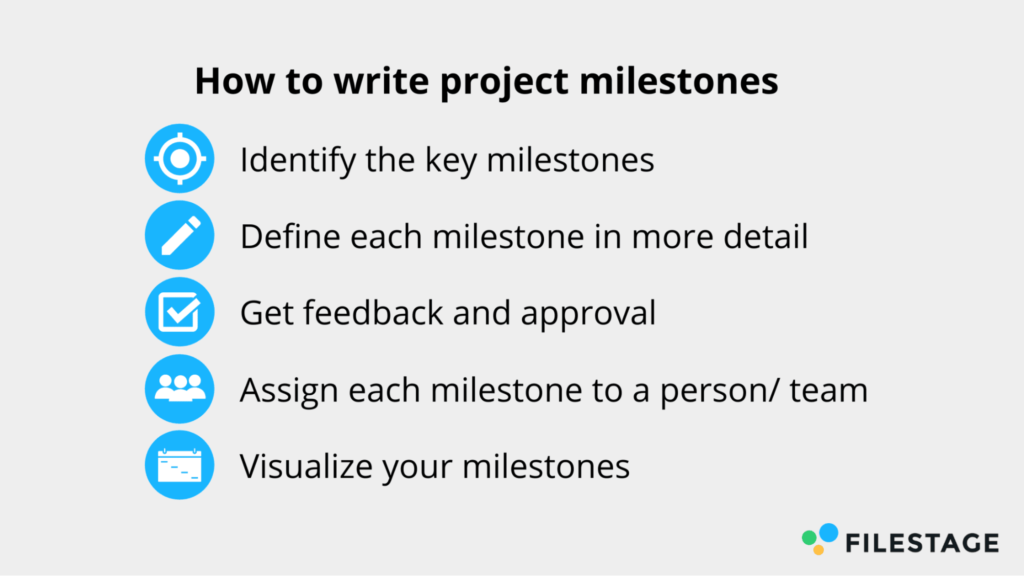
1. Identify the key milestones
These key milestones mark the important project phases. They are the main checkpoints on the way to successfully meeting the project’s schedule. For a marketing team at a company working towards the launch of a new product, the timeline for completing a media advertising outreach, public relations, and online marketing campaigns could be some major milestones.
2. Define each milestone in more detail
Now, it’s time to go into more detail. So, make sure to write out summaries for each key milestone, including a series of tasks and steps required for the completion of that project phase. These tasks can be further broken down with a detailed description of what each task entails.
3. Get feedback and approval from stakeholders
Every project has stakeholders who are in total control of its execution. These stakeholders are important in this step of project milestone writing, because they are responsible for bringing the project to completion. So, their inputs, feedback, and approval of the milestones and project plan are crucial to the project’s success.
After defining the key milestones and the smaller tasks for your project, the next step is to share your file with all relevant stakeholders, to request feedback and final approval. The easiest and fastest way to do this is with the help of a review and approval tool, like Filestage.
With this tool, you can upload your file to a centralized platform and invite reviewers. Then they can leave comments directly on the file and discuss changes with others. Once everyone is happy with the defined milestones and tasks, they can approve the file with one click.

4. Assign each milestone to a person/ team
After implementing the feedback and getting the project milestones approved, the next thing is to assign every milestone to the appropriate stakeholders. You can assign a milestone to a specific team or an individual to see it through. The creative stage of a large marketing project may be assigned to a design team, while the distribution stage could be assigned to a PR team.
5. Visualize your project phases using a Gantt chart
Statistics have shown that a lot of us tend to commit to the things we see and can visualize easily. That’s why creating project milestones should be visualized, in order to aid productivity and teamwork.
One of the ways to visualize your project milestones is with the use of a Gantt chart. They’re a method to display and track projects, using horizontal bars to reveal the project timeline, as shown in the image below.
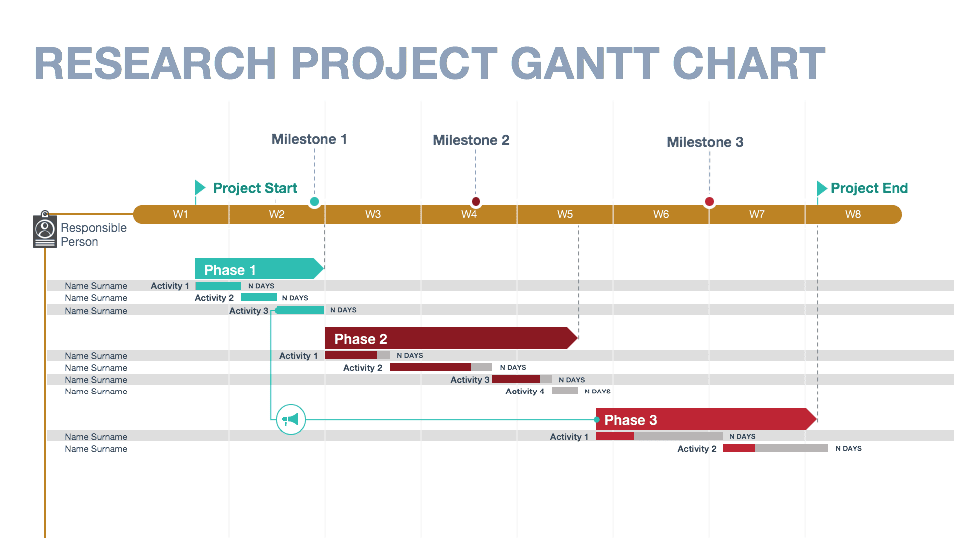
Four factors to consider when creating milestones
Like everything else that happens in our daily lives, a project might not totally go as planned. That is why there are a few factors you should consider when writing your project milestones.
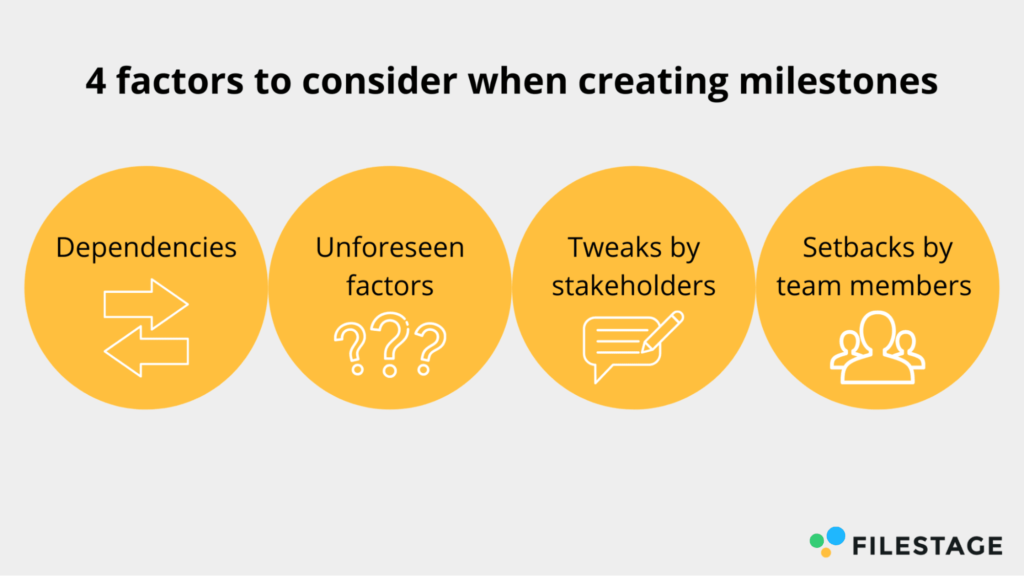
1. Dependencies
When writing a project milestone, you should consider other events that influence each milestone. These events, upon which the progress of your project relies, are known as dependencies.
There are four major types of project dependencies.
- Finish-to-start dependencies make it impossible to start the second task in a project until the first one is completed.
- Finish-to-finish dependencies tie the completion of two project phases together. This means that one phase of such a project has to be completed alongside another.
- Start-to-start dependencies ensure that two project milestones start at the same time. Starting one will almost automatically trigger the other. However, this doesn’t necessarily mean that they have to be completed together.
- Start-to-finish dependencies tie the completion of the second project milestone to the start of the first one. However, this type of dependency is not very typical.
2. Unforeseen factors
Emergencies and unplanned events can be unsettling when it comes to planning a successful project. That is why it is necessary to make provisions for the possibility of unforeseen factors. This could be the absence of a team member or holidays, crashing of a system or server, extra expenses and many more possible happenings.
3. Tweaks by clients and stakeholders
Projects usually go through review and approval processes and revisions are often requested. So, while writing a project milestone, it’s best to make provisions for the time required to incorporate feedback shared by your colleagues, clients and stakeholders.
To make this feedback collection process as frictionless as possible, you should have review rounds between project milestones, to see if you are right on track. Also, don’t forget to plan for the extra time needed for the stakeholders to review the milestone, as well as the time for revisions.
4. Setbacks by team members
We’re humans. We can’t always be perfect. That’s why it is best to make provisions for a possible falter of a team member. Anything can happen, ranging from a team member falling ill to making a mistake, or a team member submitting their part late.
It’s best to make provision for any possible setback from the team. For example, having some team members in the backend to assist when needed can help you make up for unexpected setbacks.
Differences between milestones and other terms
A lot of people mix up the meanings of milestones and terms such as project goals, tasks, deliverables, etc. These words don’t mean the same, despite having certain connections. It’s important to know the differences between these terms, to be able to understand what milestones truly are.
Difference between milestones and project goals
These two words can be interchangeable. However, a goal is a result that a person, a team or even an organization has prepared to achieve success within a specified time frame. A milestone, on the other hand, is the measurable and important accomplishment necessary to achieve a goal. The goal for an advertising campaign may be to engage 1,000 persons but the milestone covers all the tasks that need to be done to reach that goal.
Difference between milestones and tasks
Tasks are slightly different from milestones. A task is an activity that a project team or individual needs to finish in a particular time frame. A milestone is a collection of related tasks that, when completed, brings a project phase to completion. For example, an advertising campaign is the milestone of a project, which includes multiple tasks like designing the layout of social media ads, writing the ad copy or setting the campaign up in the social channels.
Difference between milestones and deliverables
A deliverable is one word that people tend to mistake for milestones. But they don’t mean the same thing. A project deliverable is a product or service that denotes the completion of a project phase. A project milestone, on the other hand, is the completed project phase. For example, a milestone can be the step of creating advertising content, while key project deliverables can be the designs or videos that have been created in that phase.
Some project milestones may not have tangible deliverables, while some may have several deliverables at intervals. However, the more likely you are to measure the deliverables, the easier it is to track the forward progress of the milestones.
Four important tips for creating project management milestones
There are many approaches to creating project milestones. These different methods can be polar opposites. However, they all require certain things to be successfully created.

1. Be specific
In creating a project milestone, you might be tempted to give very broad definitions. However, to create a project milestone that will not be misunderstood by project members, it’s best to be specific and provide some details. You can use numbers, rates or even pictures.
2. Be realistic
You obviously can’t create a milestone that you can’t achieve within the set timeframe. Meeting key milestones is very important for the accomplishment of goals. So, it is advisable to create milestones that have a realistic scope that is achievable within the specified timeframe.
3. Be timely
The essence of creating milestones is to complete the entire project on time. When writing project milestones, it’s essential to put a timeframe that the project team must adhere to. The timeframe for each milestone should be aligned with the life cycle of the larger project. This way, things will stay on track and on time.
4. Stay within budget
Finances are important for every single decision you make in project management. That is why you need to make sure to create a project milestone that stays within the specified budget without deviating. This way, you avoid having to re-budget or prepare a whole new project milestone, thus saving you extra work.
What are project milestones examples?
Figuring out what project milestones look like might seem tricky. There are so many examples of possible project milestones, used in many industries.
Let’s use the example of what the project milestones for a new product launch campaign might look like. When launching a new product, a campaign is needed to create awareness and advertise the product before it’s released to the market.
The first milestone in a campaign for a new product launch would be identifying and understanding the target audience. Every product has a specific niche and target market. To create an effective campaign, it’s important to understand who the product is aimed at and how to possibly reach them.
The next milestone is identifying the channels to reach these target audiences. This will inform your best means of advertisement (social media, print media, etc). If your target audience is young adults between 18 and 30 years, your main channels are probably social media and other internet platforms.
Some other milestones of your campaign could be creating the content for the campaign, doing test launches with volunteers and beta users, or monitoring the reactions to the launch of the product. These steps and a number of others can be key milestones to the launch of the new product.
The smarter way to request approval
Get collaborative feedback on everything from creative assets to contracts – all in one place.
Reporting on project milestones
Project milestones can also be useful in helping create progress reports for your project. Looking back on your project plan, you should be able to pull the tasks out and the milestones should provide you with all the necessary information on how your project is moving forward.
These milestones can be helpful when you are creating a report for a client, sponsor or supervisor in your office. In many professional situations, it is likely you will have to prepare some sort of project report on a regular basis, to show your sponsors or superiors how you are progressing. The milestones should provide you with all the details you will need, to present them with the information they are looking for.
When thinking of the format conventionally used to report these milestones, a table is often used. Here, you will list the milestone description, the date it was due and the new forecasted due date. Completed milestones will be added as well, along with the date they were completed.
Although these tables will make it obvious that certain goals haven’t been achieved on time, examining them in advance can offer some time for reflection, so you are able to answer the higher-ups when they ask why you weren’t able to hit a certain milestone when it was due. It will also help you look at your project management and see where improvements can be made.
Since longer projects will tend to have a lot of milestones, limit your report to include only milestones that have been completed or are pending for the current quarter. This will make less work for you and also allow your sponsor or higher-up to better focus on the progress that has been made recently, and what still needs to be done.
How to use the Gantt chart
As mentioned above, one of the most effective ways to go about the visualization of a project milestone is the use of a Gantt chart. A Gantt chart is a chart that uses horizontal bars as a representation of the project timeline. The timeline goes on the horizontal axis, while the task is listed on the vertical axis.
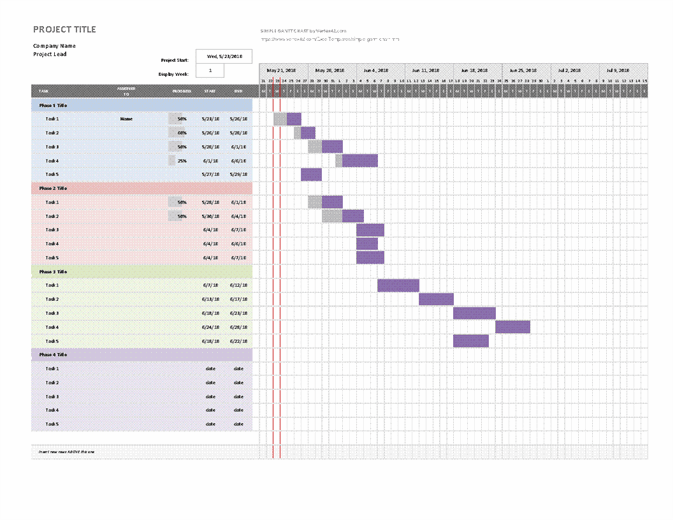
To create a Gantt chart, three types of data are needed. The first column contains all the tasks that are required to complete a project. In the next column, you can input the deadline for each of these tasks. In the third column, you could go as far as including a percentage tracker, to measure the progress of each task.
By using a Gantt chart, you get to see all the steps you need to complete each project milestone. The Gantt chart also shows dependencies between milestones, which you will have identified before.
For each milestone and task, you create a bar chart to display the start and end date. Also, to make it more appealing, you can use colors to represent different milestones, major tasks and also team responsibilities in the project. Gantt charts increase transparency, help the entire project team to visualize the progress of the project and see who each milestone is assigned to.
How to use project milestones effectively
Although milestone planning can be useful in keeping a project on track and keeping employees motivated, project managers must know how to use them to make sure they are effective. Here are some things to keep in mind when implementing milestones in your project planning.
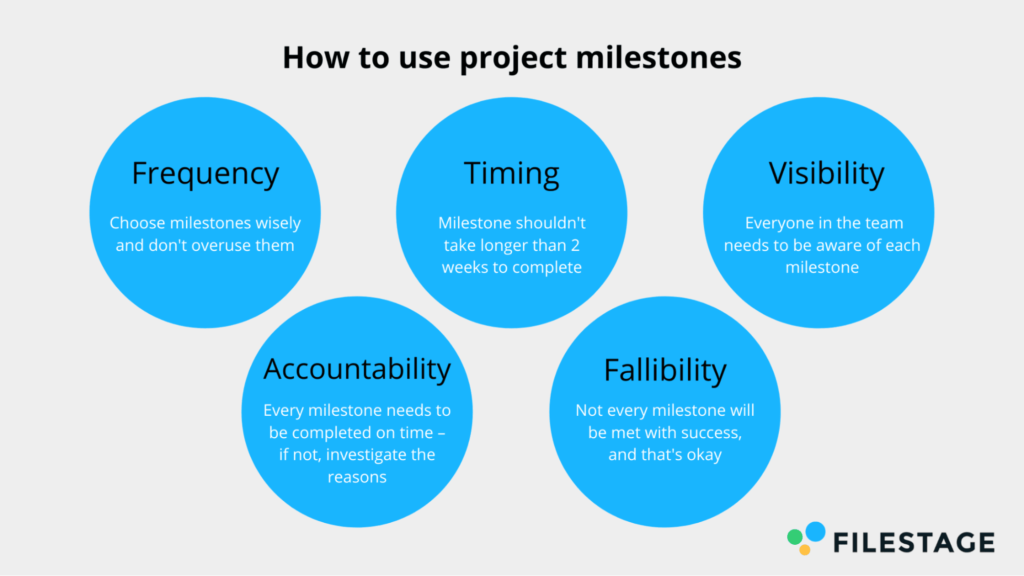
Frequency
Because milestones can work as a motivational technique, the project manager may have the tendency to overuse them. They do this by identifying tasks and other less significant goals as milestones. This frequency of use can make meeting milestones seem more commonplace and can actually cause workers to become less motivated overall.
Be sure to limit milestones to goals that can be considered junctions on a critical path and important deliverables.
Timing
While it is important not to present milestones too frequently, it is also important not to space them too far apart. This will cause your staff to lose momentum and motivation. Ideally, try to space milestones so they land approximately two weeks from each other.
Visibility
When establishing milestones, all workers should be on the same page. The project manager should be sure that their team is aware of each milestone, by distributing the necessary charts or spreadsheets to each team member and keeping them displayed prominently in the workplace.
Accountability
Every member of your team must realize the importance of meeting milestones in a timely fashion. If they are unable to do so, this is an issue that needs to be addressed immediately. If your team is unable to meet a milestone by its due date, a discussion should be held as to why this happened and what can be done to increase productivity in the future.
Fallibility
Not every milestone will be met with success, and that’s okay. In fact, it’s a good idea for the project manager to create milestones that may be more difficult to meet and may end up in failure. This can provide a learning experience for workers and give them something to aim for in the future.
Conclusion
Project milestones can seem very overwhelming sometimes, but taking the time to understand the logic behind the use of these milestones makes project management easier. By creating project milestones, you successfully split the project into smaller stages and tasks that can be distributed among the members of the team.
Project milestones make the completion of a project easier and more organized. To use project milestones well, you have to ensure timing, accountability, frequency and all other factors are considered. Project milestones are a game-changer for successful projects.

